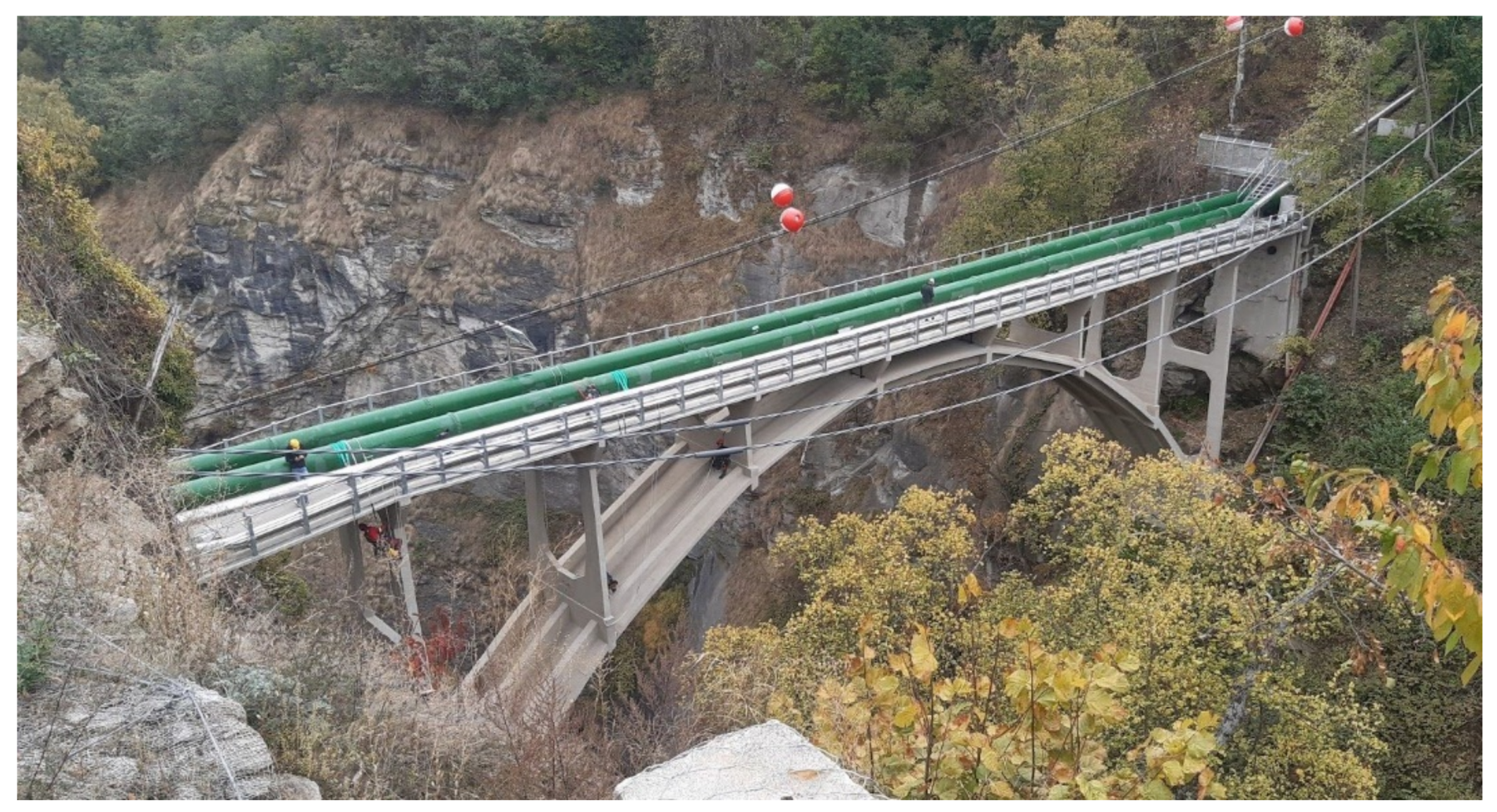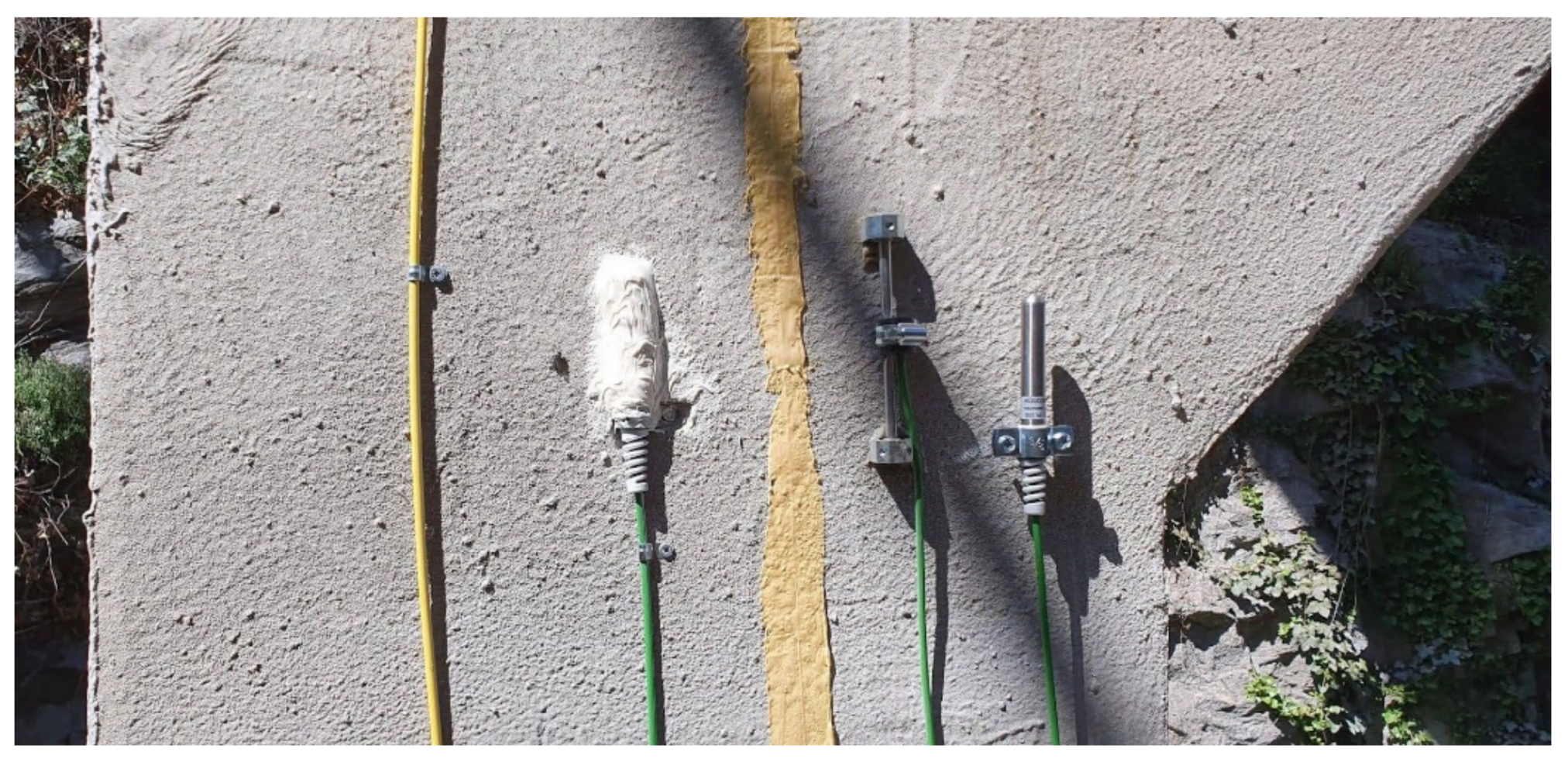Monitoring Strategic Hydraulic Infrastructures by Brillouin Distributed Fiber Optic Sensors
Abstract
:1. Introduction
2. Materials and Methods
2.1. D-FOS System
2.2. VW Extensometers, Temperature Probes and Accelerometers System
2.3. Workflow: Data Processing and Analysis
3. Results
4. Discussion and Conclusions
Author Contributions
Funding
Institutional Review Board Statement
Acknowledgments
Conflicts of Interest
References
- Chen, H.-P. Structural Health Monitoring of Large Civil Engineering Structures; John Wiley & Sons: Hoboken, NJ, USA, 2018. [Google Scholar]
- Brownjohn, J.M.W. Structural health monitoring of civil infrastructure. Philos. Trans. R. Soc. A Math. Phys. Eng. Sci. 2007, 365, 589–622. [Google Scholar] [CrossRef] [Green Version]
- Li, H.-N.; Ren, L.; Jia, Z.-G.; Yi, T.-H.; Li, D.-S. State-of-the-art in structural health monitoring of large and complex civil infrastructures. J. Civ. Struct. Health Monit. 2016, 6, 3–16. [Google Scholar] [CrossRef]
- Farrar, C.R.; Worden, K. An introduction to structural health monitoring. New Trends Vib. Based Struct. Health Monit. 2010, 365, 303–315. [Google Scholar]
- Mays, G.C. Durability of Concrete Structures: Investigation, Repair, Protection; CRC Press: Boca Raton, FL, USA, 1991. [Google Scholar]
- Baecher, G.B.; Paté, M.E.; de Neufville, R. Risk of dam failure in benefit-cost analysis. Water Resour. Res. 1980, 16, 449–456. [Google Scholar] [CrossRef]
- Evans, J.E.; Mackey, S.D.; Gottgens, J.F.; Gill, W.M. Lessons from a Dam Failure. Ohio J. Sci. 2000, 100, 121–131. [Google Scholar]
- Sills, G.L.; Vroman, N.D.; Wahl, R.E.; Schwanz, N.T. Overview of New Orleans levee failures: Lessons learned and their impact on national levee design and assessment. J. Geotech. Geoenviron. Eng. 2008, 134, 556–565. [Google Scholar] [CrossRef] [Green Version]
- Valdez, B.; Schorr, M.; Quintero, M.; García, R.; Rosas, N. Effect of climate change on durability of engineering materials in hydraulic infrastructure: An overview. Corros. Eng. Sci. Technol. 2010, 45, 34–41. [Google Scholar] [CrossRef]
- Duratorre, T.; Bombelli, G.M.; Menduni, G.; Bocchiola, D. Hydropower Potential in the Alps under Climate Change Scenarios. The Chavonne Plant, Val D’Aosta. Water 2020, 12, 2011. [Google Scholar] [CrossRef]
- Enckell, M. Structural Health Monitoring using Modern Sensor Technology–Long-term Monitoring of the New Årsta Railway Bridge. Ph.D. Thesis, KTH Royal Institute of Technology, Stockholm, Sweden, 2006. [Google Scholar]
- Liu, Y.; Nayak, S. Structural health monitoring: State of the art and perspectives. Jom 2012, 64, 789–792. [Google Scholar] [CrossRef]
- Chopra, I. Review of state of art of smart structures and integrated systems. AIAA J. 2002, 40, 2145–2187. [Google Scholar] [CrossRef]
- Hopman, V.; Kruiver, P.; Koelewijn, A.; Peters, T. How to create a smart levee. In Proceedings of the 8th international symposium on field measurements in GeoMechanics, Berlin, Germany, 12–16 September 2011; pp. 12–16. [Google Scholar]
- Sekuła, K.; Borecka, A.; Kessler, D.; Majerski, P. Smart levee in Poland. Full-scale monitoring experimental study of levees by different methods. Comput. Sci. 2017, 18, 357. [Google Scholar] [CrossRef] [Green Version]
- De Vries, G.; Koelewijn, A.R.; Hopman, V. IJkdijk Full Scale Underseepage Erosion (Piping) Test: Evaluation of Innovative Sensor Technology. In Proceedings of the International Conference on Scour and Erosion (ICSE-5), San Francisco, CA, USA, 7–10 November 2010; pp. 649–657. [Google Scholar]
- Bertulessi, M.; Bignami, D.F.; Boschini, I.; Chiarini, A.; Ferrario, M.; Mazzon, N.; Menduni, G.; Morosi, J.; Zambrini, F. Conceptualization and Prototype of an Anti-Erosion Sensing Revetment for Levee Monitoring: Experimental Tests and Numerical Modeling. Water 2020, 12, 3025. [Google Scholar] [CrossRef]
- Barrias, A.; Casas, J.R.; Villalba, S. A review of distributed optical fiber sensors for civil engineering applications. Sensors 2016, 16, 748. [Google Scholar] [CrossRef] [PubMed] [Green Version]
- Ansari, F. Practical implementation of optical fiber sensors in civil structural health monitoring. J. Intell. Mater. Syst. Struct. 2007, 18, 879–889. [Google Scholar] [CrossRef]
- Bao, X.; DeMerchant, M.; Brown, A.; Bremner, T. Tensile and compressive strain measurement in the lab and field with the distributed Brillouin scattering sensor. J. Lightwave Technol. 2001, 19, 1698. [Google Scholar]
- Bastianini, F.; Matta, F.; Rizzo, A.; Galati, N.; Nanni, A. Overview of recent bridge monitoring applications using distributed Brillouin fiber optic sensors. J. Nondestruct. Test 2007, 12, 269–276. [Google Scholar]
- Minardo, A.; Persichetti, G.; Testa, G.; Zeni, L.; Bernini, R. Long term structural health monitoring by Brillouin fibre-optic sensing: A real case. J. Geophys. Eng. 2012, 9, S64–S69. [Google Scholar] [CrossRef]
- Ohno, H.; Naruse, H.; Kihara, M.; Shimada, A. Industrial applications of the BOTDR optical fiber strain sensor. Opt. Fiber Technol. 2001, 7, 45–64. [Google Scholar] [CrossRef]
- Menduni, G.; Viani, F.; Robol, F.; Giarola, E.; Polo, A.; Oliveri, G.; Rocca, P.; Massa, A. A WSN-based architecture for the E-Museum-the experience at ‘Sala dei 500′ in Palazzo Vecchio (Florence). In Proceedings of the 2013 IEEE Antennas and Propagation Society International Symposium (APSURSI), Orlando, FL, USA, 7–13 July 2013; pp. 1114–1115. [Google Scholar]
- Motil, A.; Bergman, A.; Tur, M. State of the art of Brillouin fiber-optic distributed sensing. Opt. Laser Technol. 2016, 78, 81–103. [Google Scholar] [CrossRef]
- Ansari, F.; Libo, Y. Mechanics of bond and interface shear transfer in optical fiber sensors. J. Eng. Mech. 1998, 124, 385–394. [Google Scholar] [CrossRef]
- Montero, W.; Farag, R.; Diaz, V.; Ramirez, M.; Boada, B.L. Uncertainties associated with strain-measuring systems using resistance strain gauges. J. Strain Anal. Eng. Des. 2011, 46, 1–13. [Google Scholar] [CrossRef]
- Bastianini, F.; di Sante, R.; Falcetelli, F.; Marini, D.; Bolognini, G. Optical fiber sensing cables for Brillouin-based distributed measurements. Sensors 2019, 19, 5172. [Google Scholar] [CrossRef] [PubMed] [Green Version]
- Zou, W.; He, Z.; Hotate, K. Complete discrimination of strain and temperature using Brillouin frequency shift and birefringence in a polarization-maintaining fiber. Opt. Express 2009, 17, 1248–1255. [Google Scholar] [CrossRef] [PubMed]
- Mohamad, H.; Soga, K.; Amatya, B. Thermal strain sensing of concrete piles using Brillouin optical time domain reflectometry. Geotech. Test. J. 2014, 37, 333–346. [Google Scholar] [CrossRef]
- Lanticq, V.; Quiertant, M.; Merliot, E.; Delepine-Lesoille, S. Brillouin sensing cable: Design and experimental validation. IEEE Sens. J. 2008, 8, 1194–1201. [Google Scholar] [CrossRef]
- Lanciano, C.; Salvini, R. Monitoring of strain and temperature in an open pit using Brillouin distributed optical fiber sensors. Sensors 2020, 20, 1924. [Google Scholar] [CrossRef] [Green Version]
- Neild, S.A.; Williams, M.S.; McFadden, P.D. Development of a vibrating wire strain gauge for measuring small strains in concrete beams. Strain 2005, 41, 3–9. [Google Scholar] [CrossRef]
- Furgale, P.; Rehder, J.; Siegwart, R. Unified temporal and spatial calibration for multi-sensor systems. In Proceedings of the 2013 IEEE/RSJ International Conference on Intelligent Robots and Systems, Tokyo, Japan, 3–7 November 2013; pp. 1280–1286. [Google Scholar]














| Sensor | Quantity Installed | Acquisition Rate |
|---|---|---|
| D-FOS strain cable | ≈400 m | 30 min |
| D-FOS temperature cable | ≈400 m | 30 min |
| VW extensometer | 12 | 1 h |
| Temperature probe | 4 | 30 min |
| Accelerometer | 8 | 24 h/threshold |
| Position | Pearson’s Correlation Coefficient |
|---|---|
| A1 | 0.94 |
| A2 | 0.80 |
| A3 | 0.92 |
| A4 | 0.91 |
| B1 | 0.94 |
| B2 | 0.82 |
| B3 | 0.89 |
| B4 | 0.84 |
| C1 | 0.83 |
| C2 | 0.85 |
| C3 | 0.48 |
| C4 | 0.89 |
Publisher’s Note: MDPI stays neutral with regard to jurisdictional claims in published maps and institutional affiliations. |
© 2022 by the authors. Licensee MDPI, Basel, Switzerland. This article is an open access article distributed under the terms and conditions of the Creative Commons Attribution (CC BY) license (https://creativecommons.org/licenses/by/4.0/).
Share and Cite
Bertulessi, M.; Bignami, D.F.; Boschini, I.; Brunero, M.; Ferrario, M.; Menduni, G.; Morosi, J.; Paganone, E.J.; Zambrini, F. Monitoring Strategic Hydraulic Infrastructures by Brillouin Distributed Fiber Optic Sensors. Water 2022, 14, 188. https://doi.org/10.3390/w14020188
Bertulessi M, Bignami DF, Boschini I, Brunero M, Ferrario M, Menduni G, Morosi J, Paganone EJ, Zambrini F. Monitoring Strategic Hydraulic Infrastructures by Brillouin Distributed Fiber Optic Sensors. Water. 2022; 14(2):188. https://doi.org/10.3390/w14020188
Chicago/Turabian StyleBertulessi, Manuel, Daniele Fabrizio Bignami, Ilaria Boschini, Marco Brunero, Maddalena Ferrario, Giovanni Menduni, Jacopo Morosi, Egon Joseph Paganone, and Federica Zambrini. 2022. "Monitoring Strategic Hydraulic Infrastructures by Brillouin Distributed Fiber Optic Sensors" Water 14, no. 2: 188. https://doi.org/10.3390/w14020188
APA StyleBertulessi, M., Bignami, D. F., Boschini, I., Brunero, M., Ferrario, M., Menduni, G., Morosi, J., Paganone, E. J., & Zambrini, F. (2022). Monitoring Strategic Hydraulic Infrastructures by Brillouin Distributed Fiber Optic Sensors. Water, 14(2), 188. https://doi.org/10.3390/w14020188









